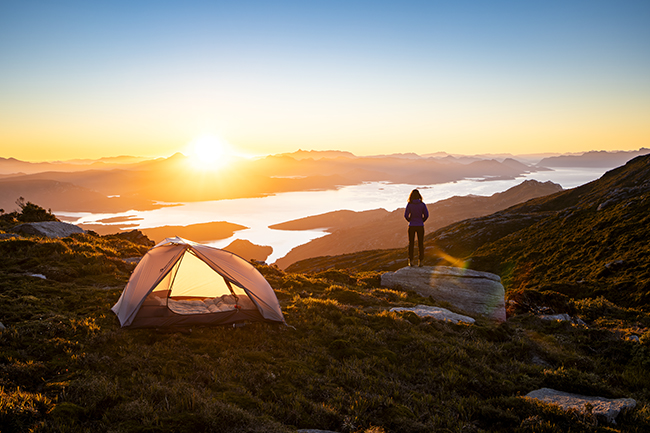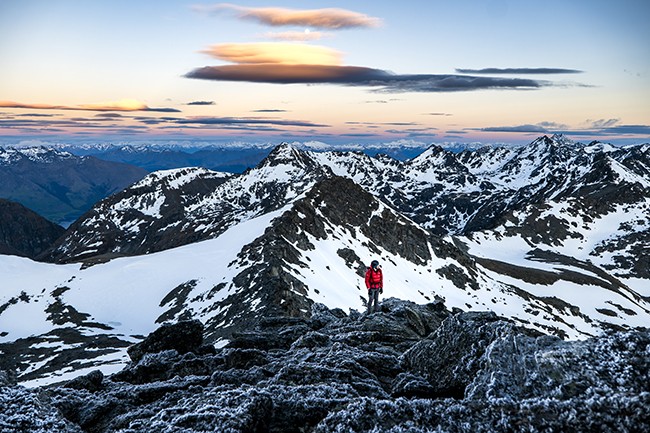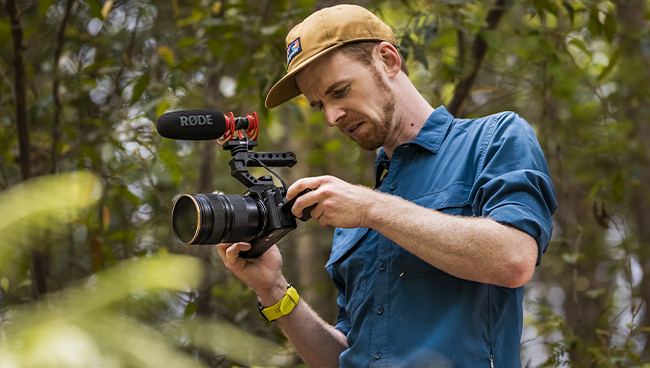
Lachlan Gardiner is a full-time freelance photographer, videographer, and occasional writer based in Brisbane, Queensland, Australia. With a career spanning 15 years, he has travelled extensively for assignments, capturing a diverse array of subjects. Specialising in striking photo and video work in the natural world, Lachlan’s true passion lies in adventure sports and outdoor activities, both as a participant and as a documenter. Join him here as he shares his journey and the breathtaking moments he’s had the privilege to capture.
Q: How did you get into adventure sports photography/videography in the first place?
I grew up on a small farm in the hinterland of the Sunshine Coast in South-East Queensland, Australia, where exploring the creeks, rivers and bushland on foot and later by mountain bike was a big part of those formative years. In my early 20s, I earned a Bachelor of Photography with Honours in Brisbane, majoring in photojournalism and documentary. Here I learned the history, ethics and practical side of photography and developed the foundations for a career as a visual storyteller. During this time, I had started to formalise some of that outdoorsy upbringing and get into rock climbing, overnight hiking and trekking. Joining clubs, along with meeting more and more like-minded people.
On all these adventures and activities, a camera would come. A few years after I graduated, travelled, and climbed (and a brief stint shooting weddings and family portraiture), I eventually began working with outdoor brands and retailers like Paddy Pallin. As my portfolio grew, my photography and adventure sports increasingly merged. On adventure trips, I was capturing advertising imagery, shooting campaigns and writing magazine features. In 2019 I was away from home for over 6-months of the year, travelling to Indonesia, Cambodia, Vietnam, Nepal, New Zealand, and all across Australia for work. The following year was set to be a similar global affair, before the COVID pandemic forced a rethink of my career trajectory. Since March 2020, I’ve only left Australia once, but the travel hasn’t slowed down. Australia has such diverse landscapes and terrain that I still feel I’ve only just begun to scratch the surface.
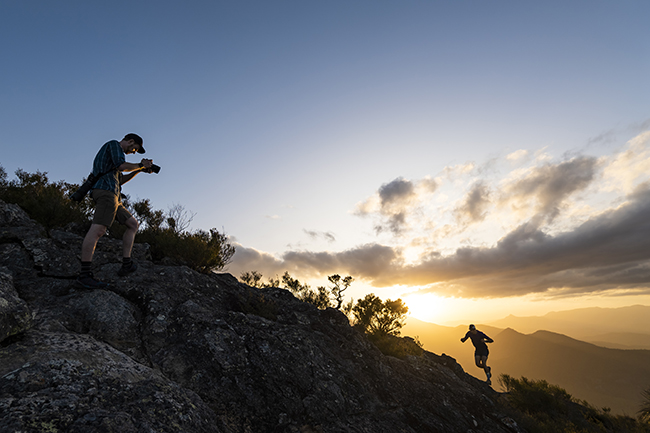
My work these days is a healthy mixture of outdoor brand campaigns, tourism content, travel operators, automotive, caravans, lifestyle and a little conservation. Plus, the occasional more traditional commercial or industrial shoot for good measure. Fairly often I’m shooting both stills and motion on projects, from initial concepts to post-production, collaborating with creative teams and athletes. This has definitely not been a simple, easy or straightforward career path. At times, making it work has been immensely tough. But the rewards and highs easily outweigh the lows, and by a hefty margin!
Q: What are the challenges you often face when shooting adventure sports? (Is there any lesson/experience that is very important/memorable for you?)
The challenges faced when capturing these types of subjects are numerous! But that is also what makes it such a rewarding experience. Here are a few thoughts and topics.
- Access – Getting to these locations—whether rugged mountaintops, steep cliff faces, or tranquil remote rivers—takes time, effort, fitness, and planning. Learn to love planning and navigating via satellite imagery and topographic maps. Wilderness locations can be sensitive places, both ecologically and culturally. Treading lightly, practicing a leave-no-trace ethos, and seeking the appropriate permissions or permits to visit are really important.
- Weather – Nature, especially the mountains, can present wild and unforgiving climatic conditions. However, I’ve learned that embracing these challenges and pushing on, even when the rain pours and blizzards howl, is key—provided it is safe to do so in the context of the particular adventure. During, or more often after, the storm passes is often when the magic happens. The light looks epic, with rainbows and low swirling clouds, showcasing nature at its finest. Frozen hands, cold wet gear, exhaustion, tropical disease, gastro, and dehydration are all challenges of operating in extreme weather (best managed or avoided whenever possible!). Otherwise, shooting at sunrise and sunset is a pretty safe bet for capturing dramatic light. Waking early to a pre-dawn alarm to capture a sunrise is something I’ve never regretted, and I’ve done it a lot!
- Skills – Shooting powerful imagery of an adventure typically means doing the activity or sport yourself. Beyond staying fit and capable, it’s all about learning the ropes (literally for climbing) and understanding how to operate and move safely through these situations and landscapes. This takes years and is a constant learning experience. Along the way, you’ll probably develop a passion (or obsession) for the sport itself. Read books, hire professional guides, join a reputable club —there are plenty of learning pathways available.

Overnight hiking in South West National Park, Tasmania, Australia. Shot with LUMIX S1 and 24-105mm F2.8
- Safety – Adventure sports inherently come with risks, but for me, it’s always been about knowing enough about the sport, activity, terrain, weather, and situation to keep those risks calculated and manageable. For a day hike, this might be as simple as taking a map, water, first aid kit, GPS, PLB or satellite communications device, and leaving your trip intentions with someone before departure. And, of course, checking the weather forecast and dressing accordingly! For more serious undertakings, such as mountaineering, factors like avalanche risk, rockfall, and high altitude come into play, to name a few. Identifying these risks and gaining the skills and experience to manage them is key.On several occasions, I’ve consciously chosen to put the camera away when the task at hand was particularly risky and serious, thus requiring my full and undivided attention. Likewise, being aware of how your actions, both as a participant or observer/photographer, can impact those around you is crucial. This might be as simple as staying off the track when a mountain biker comes hurtling past or more nuanced like traveling safely as part of a rope party through crevassed glacial terrain. In a group setting, communication is key, and so is not being afraid to speak up when the situation feels like it’s moving beyond your comfort zone in terms of safety and risk.

Alpine climbing in Southern Alps, New Zealand. Shot with LUMIX S1R and 24-105mm F2.8
- Making Images – Once you’re comfortable being out there and doing “the thing,” most of the difficult work is done. Bring a camera, a wide lens, and some spare batteries (keep these warm in extreme cold by storing them in a jacket or sleeping bag overnight!) and start documenting. Study the light and the movement of the people. The more you do it, the more you’ll start to predict compositions and know when to be ready and what settings to use. Nothing beats experience, but absorbing the work of photographers and filmmakers who inspire you is a great way to generate cool ideas.
Q: How did you overcome the challenges and what are the tips for newbies/people to start learning about this space?
The most all-encompassing and simple piece of advice I would give people is to start by doing the sport or adventure yourself. Find like-minded people with more experience than you in whatever sport or activity it is and learn EVERYTHING you can from them. Get involved, join the tribe, and be part of it. This is also a great way not only to make friends but also to find athletes and adventurous people to photograph or video. Some of my strongest friendships have been forged through sharing epic adventures with people—the bonds formed via experiencing the raw beauty of nature and physical achievement, along with suffering together, because let’s be honest… adventure sports regularly involve a generous dose of suffering. Occasionally, I’ll do solo trips and photograph myself, but it’s always far more enjoyable heading to the mountains with friends instead of just a tripod.
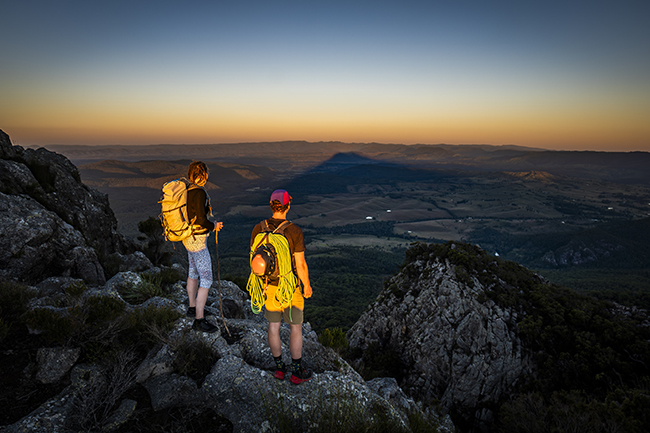
Rock climbing in Scenic Rim, Queensland, Australia. Shot with LUMIX S5 and 20-60mm F3.5-5.6
Q: How does the equipment play a role to you?
Firstly, I’m a massive gear nerd, full stop. So that extends to the equipment and clothing required for all of these adventure sports, not just the camera gear aspect. I’ve worked with the brands that make and sell outdoor gear for many years. This has always involved a mixture of using the equipment in the field, testing prototypes, reviewing, and shooting marketing material for these brands. Having appropriate gear (and knowing how to use it) is vital, especially when it comes to safety.
But back to cameras! Over the years, I’ve narrowed down what type of camera equipment functions best for what I want to achieve in my visual work: super high-quality stills and video capture in a rugged and portable package. In 2019, LUMIX was releasing their S Series Full Frame Hybrid Mirrorless system, and at that time, I was looking to transition into the mirrorless world after a decade shooting with full-frame DSLRs. The S Series ticked a lot of boxes right off the mark and has continued to impress me since. Essential for me are amazing IQ, professional features, top-tier optics, solid build quality, and outstanding “hybrid” stills + video functionality. In July 2024, it will have been 5 years since I started working full-time with the S Series system. In that time, more cameras and lenses have been released, but beyond that, LUMIX has remained committed to refining the products through regular firmware updates. This dedication to continual improvement and support of existing gear is really important to me and admirable in a brand.

Packrafting in Lake Saint Clair, Tasmania, Australia. Shot with LUMIX S1H and 24-70mm F2.8
Q: What is your favourite gear and why?
For me, having one system that is super versatile is fantastic. When shooting stills and motion advertising work, I’ll have several bodies set up for just stills and just video, with a camera rigged up with a monitor, cage, matte box, and microphone for the latter. Plus, I’ll have a collection of S and S Pro prime and zoom lenses. On the other end of the spectrum, for personal adventures and lightweight trips, I’ll strip it down—sometimes just to an S5II and a 20-60mm kit lens.
My favourite gear for stills is the timeless classic: the amazing S Pro 24-70mm F/2.8 lens, paired at the moment with the S5II. That focal length is just so versatile and suits a lot of what I shoot. Video is more complicated, but the same concept of “less is more” typically wins for lightweight carry-it-yourself adventures. The aforementioned kit of a body + lens, plus adding a screw-on variable ND filter, small shotgun microphone, and a few extra batteries—basically, you’ve got everything you need to get started shooting some adventure video content.
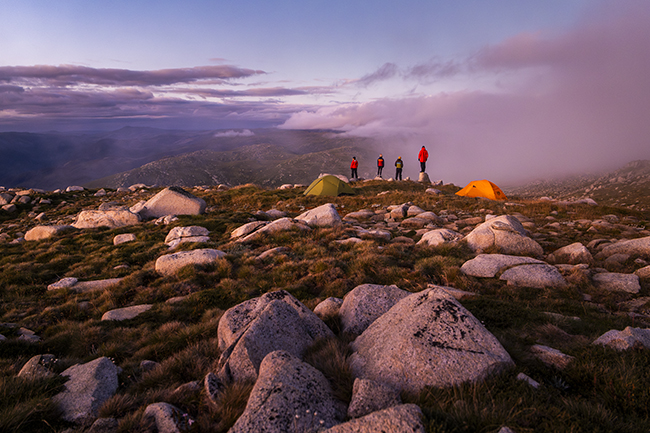
Overnight hiking in Kosciuszko National Park, New South Wales, Australia. Shot with LUMIX S5II and 24-70mm F2.8
Q: Do you have any exciting projects coming or any plan to further develop your passion?
Always! There’s plenty in the pipeline. In the coming months, I’m really looking forward to getting out in the Aussie backcountry to shoot some outdoor brand campaigns. This type of work is something I’ve come to specialize in and still absolutely love. Plus, hopefully, I’ll be able to make some time to work on some passion projects in the gaps between the commercial gigs.
This usually means challenging myself to undertake some type of human-powered adventure, which of late might be either packrafting or bike-related. Quite often, it’s the personal or passion projects where I can find the most creative freedom, and that often results in images I’m the most proud of.

